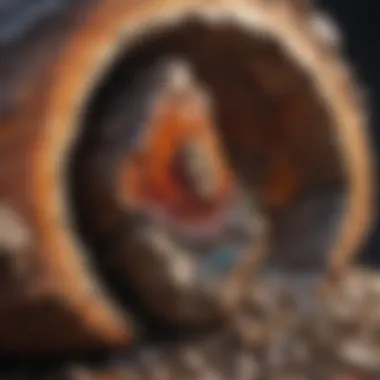Unveiling the Art of Identifying Rocks and Minerals through Visuals


Rock and Fossil Identification
As an individual keen on understanding different geological specimens, recognizing various types of rocks and minerals becomes imperative. The key to this lies in being able to distinguish between various types of rocks and fossils accurately. By having a comprehensive understanding of the characteristics to look for in rocks and fossils, enthusiasts can better differentiate between them. Additionally, employing the right tools for identification, such as magnifying glasses, hardness picks, and streak plates, can aid in the identification process.
Collecting Tips and Techniques
For rock and fossil collectors looking to enhance their collections, incorporating best practices for collecting is essential. Whether scouring a rocky terrain or exploring a fossil-rich area, knowing where and how to collect specimens can make a significant difference. Identifying prime collecting sites, which typically include areas with minimal disturbance and abundant specimens, is crucial. Moreover, understanding how to safely extract fossils and rocks without causing damage is paramount to preserving their integrity.
Preservation and Display
Once collected, the preservation of rocks and fossils is crucial to maintaining their condition over time. Techniques such as cleaning with specialized brushes and tools, as well as using sealants to prevent deterioration, can prolong the lifespan of specimens. Proper storage methods, such as keeping rocks away from sunlight and storing fossils in acid-free containers, can prevent degradation. When it comes to displaying collections, creativity plays a key role. Utilizing museum-quality display cases, organizing specimens by type or locality, and incorporating labels for educational purposes can elevate the visual appeal of the display.
Geological Insights
Delving into the geological aspects of rocks and fossils provides valuable insights into their formation and historical significance. Understanding geological formations and processes, such as sedimentation and metamorphism, offers a glimpse into the natural forces that shape the Earth. Exploring the historical significance of rocks and fossils, including their role in past ecosystems or geological events, adds depth to their value. Notable discoveries in the field of geology, whether new mineral identifications or fossil finds, contribute to expanding our knowledge of the Earth's geological history.
Introduction
In the realm of geology and mineralogy, the ability to identify rocks and minerals through visual aids holds immense significance. This article delves into the art of recognizing geological specimens using detailed pictures, catering to rock collectors, fossil enthusiasts, and anyone intrigued by the complexities of the Earth's composition. By harnessing the power of images, individuals can sharpen their classification skills and forge a deeper understanding of the diverse array of rocks and minerals that exist.
Understanding the Importance of Visual Identification
Utilizing Pictures for Accurate Classification
When it comes to accurately categorizing rocks and minerals, leveraging pictures plays a vital role in this process. By capturing high-quality images of specimens, individuals can scrutinize intricate details that might be challenging to discern with the naked eye alone. The utilization of pictures not only enhances the precision of classification but also grants enthusiasts the ability to archive their findings visually. This inclusion of visual data not only aids in accurate identification but also serves as a valuable resource for future reference, contributing to a more thorough understanding of geological samples.
Enhancing Identification Skills through Visual Cues
Visual cues offer a gateway to honing identification skills by training the eye to recognize subtle differences in characteristics. Incorporating visual cues such as color variations, texture patterns, and structural irregularities enables enthusiasts to develop a keen eye for detail. This practice not only enhances the identification process but also cultivates a deeper appreciation for the nuances present in various rocks and minerals. By immersing oneself in the visual realm of geological specimens, individuals can elevate their expertise and foster a more profound connection with the Earth's geological tapestry.


Overview of Common Rocks and Minerals
Key Characteristics to Look For
When embarking on the journey of rock and mineral identification, certain key characteristics serve as pivotal markers for differentiation. Understanding features such as color intensity, mineral luster, and crystal structures empowers enthusiasts to make informed classifications. By paying close attention to these essential traits, individuals can navigate through the vast spectrum of rocks and minerals with confidence, thereby streamlining the identification process.
Distinctive Features of Different Types
Exploring the distinctive features inherent in various types of rocks and minerals unveils a treasure trove of geological diversity. Each specimen boasts unique traits such as cleavage patterns, density variations, and specific mineral compositions that set them apart. By delving into these distinctive attributes, enthusiasts gain a deeper insight into the intricacies of Earth's geological makeup, paving the way for a more nuanced understanding of rock and mineral classification. Embracing the nuances of each type enriches the identification journey, offering a comprehensive exploration of the geological wonders that abound.
Tools and Equipment
In the realm of identifying rocks and minerals with pictures, the use of tools and equipment holds paramount significance. These instruments play a crucial role in aiding enthusiasts, collectors, and geologists in the accurate classification and analysis of geological specimens. By delving into the world of tools and equipment, individuals can elevate their identification skills and delve deeper into the intricate details that define different rocks and minerals. Understanding the specific elements, benefits, and considerations surrounding tools and equipment is key to mastering the art of visual identification.
Essential Tools for Rock and Mineral Identification
Magnifying Glass and Hand Lens
Engaging with a magnifying glass and hand lens unveils a new realm of detail and clarity when inspecting rocks and minerals. The magnifying capability of these tools allows users to zoom in on minuscule features and textures that are otherwise imperceptible to the naked eye. This enhanced level of examination aids in the identification process by providing a closer look at crystal structures, mineral patterns, and unique characteristics that define various specimens. The portability and ease of use make the magnifying glass and hand lens perfect companions for fieldwork and indoor analysis, making them popular choices among enthusiasts seeking precision and detail in their visual identification endeavors.
Streak Plates and Hardness Picks
On the other hand, streak plates and hardness picks offer a different dimension to rock and mineral identification. These tools assist in determining the hardness of a specimen by testing its resistance to scratching and abrasion. The streak plate, used to assess mineral streak colors, and the hardness pick, which aids in identifying the Mohs hardness scale of a mineral, provide valuable insights into the physical properties of rocks and minerals. While streak plates reveal the color of a mineral's powder, hardness picks help classify minerals based on their scratch resistance, enabling enthusiasts to further refine their identification processes with tangible data points. Each tool brings its unique advantage to the identification toolkit, allowing for a comprehensive examination of different geological specimens.
Camera and Lighting Setup
Exploring the realm of visual identification transcends the physical tools themselves and extends into the realm of capturing detailed images. The camera and lighting setup are integral components in creating high-quality visual records that aid in the precise analysis of rocks and minerals. By optimizing image quality for detailed analysis, enthusiasts can highlight intricate details, colors, and textures that define each specimen, allowing for a thorough examination of key features. Proper lighting plays a crucial role in capturing accurate representations of rocks and minerals, as it illuminates the specimen in a way that enhances its unique characteristics and facilitates in-depth analysis. As such, investing in a quality camera and understanding the importance of optimal lighting setups are vital considerations for those seeking to excel in the field of identifying rocks and minerals through pictures.
Photographing Rocks and Minerals
In the realm of rock and mineral identification, the ability to capture precise and detailed images holds immense significance. Photographing rocks and minerals serves as a crucial component in this guide, allowing enthusiasts and collectors alike to delve deep into the intricate characteristics of geological specimens. By incorporating visuals, individuals can elevate their understanding and classification accuracy, honing their skills to recognize the subtle nuances that differentiate one rock or mineral from another.


Best Practices for Capturing Detailed Images
Utilizing Macro Mode for Close-up Shots
Discussing the practical application of utilizing the Macro mode for close-up shots unveils a fundamental technique embraced by many in the field. Macro mode, characterized by its capability to capture intricate details with exceptional clarity and precision, stands as a preferred choice within the context of this article. The unique feature of Macro mode lies in its ability to magnify textures and features that might be imperceptible to the naked eye, offering a closer look at the intricate composition of rocks and minerals. However, it's essential to note that using Macro mode may have limitations in capturing overall contextual views, requiring users to balance detailed shots with broader perspectives.
Focusing on Texture and Color Variation
Emphasizing the importance of focusing on texture and color variation in photography plays a vital role in rock and mineral identification. By centering on these aspects, individuals can discern crucial differences that aid in accurate categorization. Texture analysis allows for the differentiation of various rocks based on surface characteristics, while color variations indicate the presence of specific mineral compositions. This deliberate focus on texture and color not only enhances the visual appeal of the images but also provides valuable insights into the geological properties of the specimens. However, challenges may arise in portraying accurate color depictions under varying lighting conditions, necessitating a nuanced approach to capture true-to-life representations.
Angles and Perspectives
Highlighting Different Angles for Comprehensive View
The exploration of different angles when photographing rocks and minerals amplifies the depth of understanding for enthusiasts and collectors. By showcasing specimens from various perspectives, individuals gain a holistic view, enabling a comprehensive analysis of the geological features present. Highlighting distinct angles accentuates unique attributes that may go unnoticed in single-dimensional images, allowing for a more thorough exploration of the specimen's characteristics. Despite its benefits, diversifying angles may present challenges in maintaining consistent image quality and composition, underscoring the need for a balanced approach in capturing comprehensive views.
Utilizing Natural Light for Authentic Representation
Utilizing natural light as a primary light source in rock and mineral photography plays a pivotal role in achieving authenticity and accuracy in image representation. The characteristic of natural light offers a true-to-life depiction of colors and textures present in the specimens, facilitating a genuine portrayal of their geological composition. By harnessing natural light, photographers can enhance the visual clarity and detail of images, showcasing the specimens in their most accurate form. However, reliance on natural light may pose challenges in controlling shadows and highlights, requiring careful consideration of positioning and timing to ensure optimal image capture.
Interpreting Visual Clues
Understanding the importance of interpreting visual clues in this article is fundamental for rock and fossil enthusiasts and collectors. By delving into visual cues, individuals can enhance their ability to accurately identify rocks and minerals. Visual interpretation offers a holistic view, allowing for a more thorough analysis of geological specimens. Through a detailed examination of images, enthusiasts can uncover intricate details that may not be apparent through conventional methods. These clues provide valuable insights into the composition, structure, and unique characteristics of rocks and minerals, aiding in their classification and categorization.
Analyzing Crystal Structures and Mineral Patterns
Identifying Crystal Forms through Images
Identifying crystal forms through images plays a pivotal role in the overall process of rock and mineral identification. By scrutinizing crystal formations in photographs, enthusiasts can discern specific patterns and structures that are indicative of certain minerals. The key characteristic of this method lies in its ability to visually represent the intricate details of crystals, making it a popular choice for this article. The unique feature of identifying crystal forms through images is its capacity to showcase the precise geometric arrangements of crystals, aiding in accurate mineral classification. While this approach offers a visual feast of crystal intricacies, it may pose challenges in capturing minute details accurately, requiring a keen eye and attention to detail for effective interpretation.


Recognizing Cleavage and Fracture Patterns
The ability to recognize cleavage and fracture patterns through visual analysis significantly contributes to understanding the characteristics of rocks and minerals. By observing the ways in which minerals break along planes or irregular surfaces, enthusiasts can infer valuable information about their composition and internal structure. Highlighting the defining characteristics of cleavage and fracture patterns allows for a deeper comprehension of mineral properties, making it a beneficial choice for this article. The unique feature of this method lies in its capacity to reveal how minerals respond to external forces, providing insights into their physical properties and behavior. While recognizing cleavage and fracture patterns offers substantial insights, it may require expertise to differentiate between subtle variations and accurately interpret these visual indicators.
Color and Texture Insights
Correlating Color Variations with Mineral Composition
Correlating color variations with mineral composition is a crucial aspect of rock and mineral identification. By analyzing the hues present in photographs, enthusiasts can draw connections between specific colors and the types of minerals they represent. The key characteristic of this approach is its ability to provide valuable clues about mineral content, offering a visual roadmap for classification. The unique feature of correlating color variations with mineral composition is its capacity to aid in quick visual identification, enabling enthusiasts to make preliminary assessments based on color cues. While this method facilitates rapid mineral recognition, it may also lead to misinterpretations if not supported by additional visual and contextual information.
Texture Analysis for Differentiating Rocks
Texture analysis for differentiating rocks is an essential technique in the realm of geological specimen identification. By examining the surface textures captured in images, enthusiasts can distinguish between various rock types based on their tactile properties. The key characteristic of this method is its emphasis on the tactile qualities of rocks, allowing for a sensory exploration of geological specimens. The unique feature of texture analysis lies in its capacity to provide a hands-on approach to identification, offering a tactile dimension to visual assessments. While this technique offers valuable insights into rock differentiation, it may require supplementary information to account for variations in texture appearance due to factors such as lighting conditions and camera resolution.
Case Studies and Examples
In the realm of identifying rocks and minerals with pictures, case studies and examples play a pivotal role. These components provide tangible illustrations of geological specimens, aiding enthusiasts and collectors in honing their classification skills. By presenting real-life scenarios and detailed examples, readers can deepen their understanding of the key characteristics to look for when differentiating rocks and minerals. Case studies offer practical insights into the challenges faced during identification processes, thereby equipping individuals with the necessary knowledge to overcome similar obstacles. Furthermore, examples serve as visual references, allowing readers to apply theoretical concepts to practical situations, enhancing their overall proficiency in rock and mineral identification.
Visual Comparisons of Similar Minerals
Side-by-Side Images for Contrasting Features
The utilization of side-by-side images for contrasting features is an invaluable tool within the context of rock and mineral identification. This technique involves juxtaposing two similar minerals or rocks to highlight their distinguishing characteristics, facilitating a comparative analysis. By presenting specimens side by side, readers can easily pinpoint differences in color, texture, crystal structure, and other key traits essential for accurate classification. This method enables viewers to develop a keen eye for subtle variations, enhancing their ability to discern nuanced details that differentiate closely related minerals. Ultimately, side-by-side images contribute significantly to enhancing visual acuity and sharpening identification skills, making them a preferred choice for elucidating distinctions among similar geological specimens.
Detailed Examinations of Look-Alike Specimens
Detailed examinations of look-alike specimens offer a comprehensive exploration of visually similar rocks and minerals. This analytical approach involves in-depth scrutiny of minute details, such as crystal forms, cleavage patterns, and textural variations, to distinguish between nearly identical geological entities. By conducting thorough inspections and detailed assessments, readers can uncover subtle nuances that set each specimen apart, facilitating accurate identification. The meticulous examination of look-alike specimens enhances observational skills and fosters a deeper appreciation for the intricacies of geological diversity. While this method requires patience and attention to detail, the rewards include a heightened ability to differentiate between seemingly indistinguishable rocks and minerals, making it an indispensable technique in the field of visual identification.
Real-Life Applications of Image Identification
Practical Uses of Visual Analysis in Geology
The practical uses of visual analysis in geology extend beyond academic study, offering valuable insights for professionals and enthusiasts alike. By harnessing the power of visual examination, geologists can analyze the mineral composition, crystal structures, and textural characteristics of rocks with precision and accuracy. This method enables geologists to identify key indicators that aid in geological mapping, resource exploration, and structural analysis. Moreover, visual analysis plays a fundamental role in environmental assessments and land surveying, providing essential information for decision-making processes in various industries. The practical applications of visual analysis in geology underscore its significance in understanding Earth's landscape and mineral resources, making it an indispensable tool for geologists and rock enthusiasts.
Challenges and Solutions in Identification
Navigating the challenges posed by rock and mineral identification requires a systematic approach and a keen eye for detail. Geologists and collectors often encounter obstacles such as ambiguous color variations, cryptic textures, and confounding crystal structures that complicate the classification process. To address these challenges, individuals must employ innovative solutions, such as cross-referencing multiple sources, consulting with experts, and utilizing specialized equipment for enhanced analysis. By embracing these challenges as opportunities for growth and learning, enthusiasts can develop a robust skill set that enables them to overcome obstacles with confidence and proficiency. Ultimately, overcoming challenges in identification not only enhances one's diagnostic capabilities but also fosters a deeper understanding and appreciation for the vast diversity present in the world of rocks and minerals.







